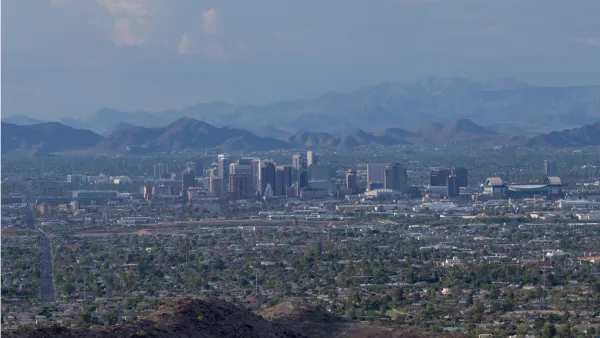Emma Marris reviews a new book by Andrew Ross, a cultural critic at New York University, that tries to understand how Phoenix came to be what it is, and determine whether there's any way it can be turned around.
Rather than focusing on the sustainability success stories being advanced by the converted in cities like Portland and San Francisco, Ross suggests that more important lessons about large scale climate change intervention can be gained from observing efforts to introduce green initiatives in cities like Phoenix, which are, "the weakest links in a chain that has to be strengthened tenfold" if the planet is to remain livable in the face of climate change." And this is the focus of Ross's new book, Bird on Fire: Lessons from the World's Least Sustainable City
As Marris notes, the challenges faced by Phoenix are daunting, "it uses a huge amount of water for a desert community -- more than twice the per capita rate of Seattle, which gets nearly 39 inches of rainfall a year -- and pumps most of it more than 300 miles uphill from the overtaxed Colorado River. Its air is brown with smog; its shadeless concrete landscape absorbs heat. And its black and Latino neighborhoods are cesspools of toxic waste."
And sustainable solutions to those challenges will be hard to come by within the city's traditional model for economic development based on continued outward physical growth. Sadly, in interviews with the real estate powers that be, Ross finds that they are, "more excited about designing green on a blank slate than doing the complex and less glamorous work of increasing density in the central city," which is perhaps the only way for the city to grow sustainably.
In the end, however, Ross seems skeptical of the prospects for achieving sustainability with any type of growth. According to Marris, "[h]e does not believe in the notion of sustainable growth. True sustainability, he argues, consists of rejecting growth and -- crucially -- achieving social equality. Over and over he returns to the notion that you can't buy your way out of an environmental hole with cool gadgets marketed to middle-class people."
Thanks to Scott Dodd
FULL STORY: Bird on Fire: Lessons from the World's Least Sustainable City (Book Review)

National Parks Layoffs Will Cause Communities to Lose Billions
Thousands of essential park workers were laid off this week, just before the busy spring break season.

Retro-silient?: America’s First “Eco-burb,” The Woodlands Turns 50
A master-planned community north of Houston offers lessons on green infrastructure and resilient design, but falls short of its founder’s lofty affordability and walkability goals.

Delivering for America Plan Will Downgrade Mail Service in at Least 49.5 Percent of Zip Codes
Republican and Democrat lawmakers criticize the plan for its disproportionate negative impact on rural communities.

Test News Post 1
This is a summary

Test News Headline 46
Test for the image on the front page.

Balancing Bombs and Butterflies: How the National Guard Protects a Rare Species
The National Guard at Fort Indiantown Gap uses GIS technology and land management strategies to balance military training with conservation efforts, ensuring the survival of the rare eastern regal fritillary butterfly.
Urban Design for Planners 1: Software Tools
This six-course series explores essential urban design concepts using open source software and equips planners with the tools they need to participate fully in the urban design process.
Planning for Universal Design
Learn the tools for implementing Universal Design in planning regulations.
EMC Planning Group, Inc.
Planetizen
Planetizen
Mpact (formerly Rail~Volution)
Great Falls Development Authority, Inc.
HUDs Office of Policy Development and Research
NYU Wagner Graduate School of Public Service



























